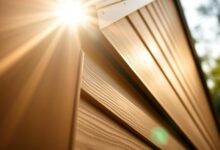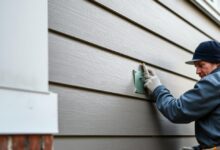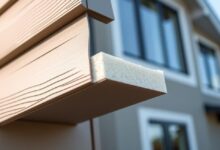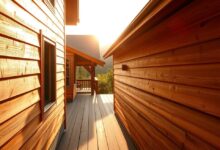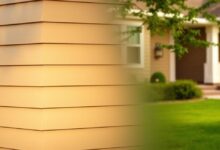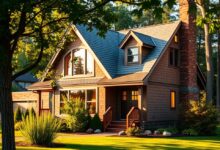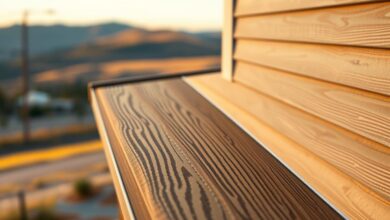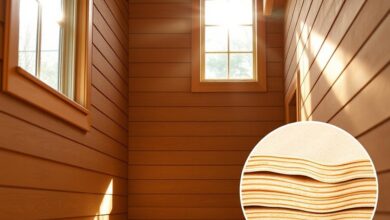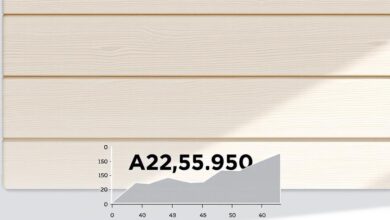Reduce Noise with Insulated Siding for Your Home
A quieter home is essential for comfort and relaxation. Noise pollution can really affect your life, making it hard to focus or relax. Using insulated siding is a great way to cut down on outside noise.
Installing noise reduction siding can make your home quieter. It also makes your home more energy-efficient. This means a more comfortable place to live.
Key Takeaways
- Insulated siding helps in reducing external noise.
- It enhances home comfort by maintaining a consistent indoor temperature.
- Noise reduction siding is an effective solution for noise pollution.
- It improves the overall energy efficiency of your home.
- A quieter home environment improves quality of life.
Understanding Noise Pollution and Its Impact on Home Comfort
Noise pollution is a big problem that makes our homes less comfortable. It’s important to know where this noise comes from and how it affects us. This knowledge helps us find ways to solve the issue.
Common Sources of External Noise
External noise can come from many places, including:
- Traffic and highways
- Airports and flight paths
- Neighborhood noise from parties or construction
- Industrial areas
These sources can make a lot of noise around our homes. It’s hard to relax or focus because of it.
How Noise Affects Health and Well-being
Noise pollution is more than just a bother. It can really harm our health and happiness. Being around too much noise for a long time can cause serious health problems.
Sleep Disruption and Stress
One big problem with noise pollution is sleep disruption. It’s hard to sleep well when there’s a lot of noise. This can lead to stress and anxiety, hurting our mental health.
Productivity and Concentration Issues
Noise pollution also makes it hard to focus and be productive. It’s tough to concentrate in a noisy place. This can make us less productive and more frustrated.
How Insulated Siding for Noise Reduction Works
Understanding insulated siding is key to its noise reduction. It’s designed to block outside noise from entering your home.
The Science Behind Sound Dampening
Sound dampening uses materials that soak up sound energy, not pass it on. Insulated siding has an outer layer, like vinyl, and a foam insulation layer. This combo cuts down sound passing through.
Sound Transmission Class (STC) Ratings Explained
The STC rating shows how well siding blocks noise. A higher STC means better sound insulation. For example, high STC insulated siding greatly reduces outside noise, making your home quieter.
Insulated vs. Traditional Siding Materials
Traditional siding, like regular vinyl or wood, doesn’t have insulation. Insulated siding benefits include less noise and better energy use. It makes your home quieter and more comfortable.
In summary, insulated siding’s noise reduction comes from its design and materials. Its high STC ratings and comparison to traditional siding make it a top choice for quiet homes.
Types of Insulated Siding Options Available
Homeowners have many choices when it comes to insulated siding. The best option depends on your budget, climate, and what you like. This type of siding not only cuts down on noise but also saves energy and lasts longer.
Vinyl Insulated Siding
Vinyl insulated siding is a favorite because it’s affordable and easy to care for. It has insulation in the middle, between vinyl and a backing. This setup reduces noise and boosts energy efficiency.
Fiber Cement Insulated Options
Fiber cement insulated siding is strong and can handle tough weather. It’s made from cement, sand, and cellulose fibers. This siding stands up well to extreme temperatures and weather.
Foam-Backed Siding Systems
Foam-backed siding systems are great for keeping things warm or cool. They have a foam layer on the back of the siding.
Expanded Polystyrene (EPS) Backing
EPS backing is a common foam used in siding. It’s light and insulates well. EPS is also cheap and simple to put up.
Contoured vs. Flat Foam Backing
Foam backing comes in different shapes, like contoured and flat. Contoured foam backing fits the siding’s shape for better insulation. Flat foam is simpler and cheaper to make.
In conclusion, picking insulated siding depends on your budget, how durable you want it, and how much noise you want to block. You can choose from vinyl, fiber cement, or foam-backed siding. Each has its own benefits.
Benefits Beyond Noise Reduction
Insulated siding does more than just reduce noise. It makes your home more comfortable and increases its value. It brings many benefits that can greatly enhance your living space.
Energy Efficiency Improvements
Insulated siding boosts energy efficiency. It adds an extra layer of insulation. This helps keep your home warm in winter and cool in summer. You’ll save on energy bills and enjoy a more comfortable home.
Increased Home Value
Adding insulated siding can increase your home’s value. Homes with energy-saving features and durable exteriors attract buyers. This makes your home more appealing if you plan to sell.
Enhanced Durability and Weather Resistance
Insulated siding is built to last and withstand harsh weather. It can handle heavy rain, snow, and extreme temperatures. This means fewer repairs and replacements over time.
Aesthetic Options and Curb Appeal
Modern insulated siding comes in many styles and colors. This lets homeowners boost their home’s curb appeal while enjoying practical benefits. Whether you like vinyl, fiber cement, or something else, there’s an option for you.
Selecting the Right Insulated Siding for Your Noise Issues
Effective noise reduction starts with identifying the noise type and choosing the right siding. Noise issues vary greatly from home to home. This depends on location and the environment around your home.
Assessing Your Specific Noise Problems
To pick the right insulated siding, first figure out the noise you want to block. Is it constant traffic noise, aircraft noise, or noise from neighbors? Knowing the noise source and its characteristics is key.
Matching Siding Types to Noise Frequencies
Different insulated siding types work better against different noise frequencies. For example, foam-backed siding is great for low-frequency noises like traffic rumble. On the other hand, vinyl insulated siding is better for higher frequency sounds.
Here’s a look at some common siding types and their noise reduction abilities:
- Vinyl Insulated Siding: Good against high-frequency noise.
- Fiber Cement Insulated Options: Works well against a wide range of noise frequencies.
- Foam-Backed Siding Systems: Best for low-frequency noise.
Complementary Noise Reduction Strategies
Insulated siding is a strong tool for noise reduction, but it works best with other strategies. This includes sealing gaps around windows and doors. Also, using soundproofing materials in walls and ceilings helps. Planting trees or shrubs can act as natural sound barriers.
By using insulated siding with these strategies, homeowners can greatly improve their home’s comfort and peace.
Installation and Maintenance Considerations
Insulated siding works well if installed right and kept up. Homeowners need to think about a few things to make sure it works best.
Professional vs. DIY Installation
Choosing between a pro or DIY install depends on the job’s complexity and your skills. DIY can be cheaper, but professional installation makes sure it’s done right. This means better performance.
Proper Sealing and Insulation Techniques
Sealing and insulating right is key for insulated siding. You need to seal all gaps and attach it properly. Proper techniques help it block noise and save energy.
Long-term Maintenance Requirements
Keeping insulated siding in good shape is important. This includes:
- Regular cleaning to prevent dirt buildup
- Periodic inspections to identify any damage or wear
- Prompt repair or replacement of damaged sections
Cleaning and Inspection
Check your siding often for damage or wear. Clean it gently to avoid harm.
Repair and Replacement Guidelines
Fix damage quickly. Sometimes, you might need to replace parts. Always follow the manufacturer’s advice for repairs and replacements.
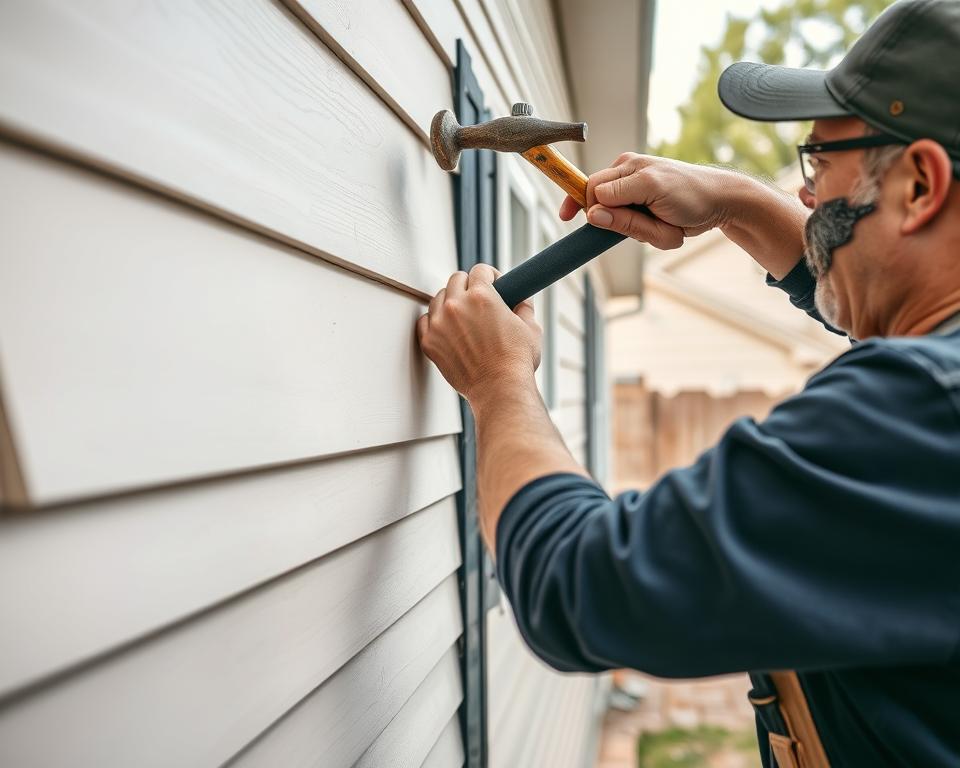
Conclusion: Creating a Quieter, More Comfortable Home Environment
Insulated siding is key in reducing noise and making homes more comfortable. There are many types, like vinyl, fiber cement, and foam-backed systems. They offer benefits beyond just quieting down your home.
Insulated siding makes homes quieter and more energy-efficient. It also boosts your home’s value and makes it last longer against the weather. By picking the right insulated siding for your noise problems, you can greatly improve your home.
With the right installation and care, insulated siding is a smart choice for your home. It makes your living space more peaceful and comfortable. This upgrade is a big step towards a better living environment, making your home quieter and more enjoyable.
